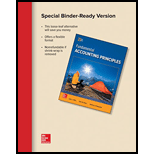
Concept explainers
Concept Introduction:
Cost flow assumptions:
Cost flow assumptions refers to the methods available for assigning costs to the cost of goods sold and the ending inventory. The different methods that are available for assigning costs to inventories are FIFO, LIFO and weighted average cost of goods sold.
First-in, first-out (FIFO):
In FIFO method of inventory, the cost of goods sold and ending inventory are valued at the older prices. The cost of goods sold are valued at the older prices and the inventory which remains unsold are with the newest prices. This method says that, the inventory first purchased is first sold the ending inventory consists of the latest purchases.
Last-in, first-out (LIFO):
In LIFO method of inventory, the cost of goods sold and ending inventory are valued at the latest or the newest prices. The cost of goods sold are valued at the newest prices and the inventory which remains unsold are valued at the oldest prices. This method says that, the inventory last purchased is first sold and the ending inventory consists of the oldest purchases.
Weighted average cost method:
In weighted average cost method, the cost of goods sold and ending merchandise inventories are valued as price which is derived by dividing total cost of goods available for sale by total units available for sale
Accounting treatment of Increase of Decrease in value of inventory under US GAAP and IFRS:
The US GAAP and IFRS both requires the inventory to be valued at
Accounting treatment of Increase of Decrease in value of inventory under US GAAP:
US GAAP requires companies to write down inventory when its value falls below the cost at which is it purchased or recorded. US GAAP requires companies to record their inventory at lower of cost or market value.
Any increase in the value of inventory is not permitted to be recorded under US GAAP even if the company had reduced the value of inventory in the previous year.
Accounting treatment of Increase of Decrease in value of inventory under IFRS:
IFRS requires companies to write down inventory when its value falls below the cost at which is it purchased or recorded. IFRS requires companies to record their inventory at lower of cost or market value.
IFRS allows companies to reverse the reduction in inventory carried in the previous periods, if the value of inventory increases in the current period. But the increase in inventory cannot exceed the original acquisition cost of inventory
Requirement 1
To determine:
The cost flow assumption that Samsung apply in assigning costs to its inventories.
Requirement 2
To explain:
How the increase in the value of inventory would be recorded under US GAAP and IFRS for Samsung.
Want to see the full answer?
Check out a sample textbook solution
Chapter 6 Solutions
Loose Leaf for Fundamental Accounting Principles
- I need assistance with this general accounting question using appropriate principles.arrow_forwardPlease show me the correct approach to solving this financial accounting question with proper techniques.arrow_forwardPlease provide the solution to this general accounting question using proper accounting principles.arrow_forward
- I need help finding the correct solution to this financial accounting problem with valid methods.arrow_forwardPlease explain the solution to this financial accounting problem using the correct financial principles.arrow_forwardCan you solve this general accounting problem with appropriate steps and explanations?arrow_forward
- Please provide the correct answer to this financial accounting problem using valid calculations.arrow_forwardPlease provide the solution to this general accounting question using proper accounting principles.arrow_forwardCan you solve this financial accounting problem using appropriate financial principles?arrow_forward

 AccountingAccountingISBN:9781337272094Author:WARREN, Carl S., Reeve, James M., Duchac, Jonathan E.Publisher:Cengage Learning,
AccountingAccountingISBN:9781337272094Author:WARREN, Carl S., Reeve, James M., Duchac, Jonathan E.Publisher:Cengage Learning, Accounting Information SystemsAccountingISBN:9781337619202Author:Hall, James A.Publisher:Cengage Learning,
Accounting Information SystemsAccountingISBN:9781337619202Author:Hall, James A.Publisher:Cengage Learning, Horngren's Cost Accounting: A Managerial Emphasis...AccountingISBN:9780134475585Author:Srikant M. Datar, Madhav V. RajanPublisher:PEARSON
Horngren's Cost Accounting: A Managerial Emphasis...AccountingISBN:9780134475585Author:Srikant M. Datar, Madhav V. RajanPublisher:PEARSON Intermediate AccountingAccountingISBN:9781259722660Author:J. David Spiceland, Mark W. Nelson, Wayne M ThomasPublisher:McGraw-Hill Education
Intermediate AccountingAccountingISBN:9781259722660Author:J. David Spiceland, Mark W. Nelson, Wayne M ThomasPublisher:McGraw-Hill Education Financial and Managerial AccountingAccountingISBN:9781259726705Author:John J Wild, Ken W. Shaw, Barbara Chiappetta Fundamental Accounting PrinciplesPublisher:McGraw-Hill Education
Financial and Managerial AccountingAccountingISBN:9781259726705Author:John J Wild, Ken W. Shaw, Barbara Chiappetta Fundamental Accounting PrinciplesPublisher:McGraw-Hill Education





